
Tuolumne Meadows is a gentle, dome-studded, sub-alpine meadow area along the Tuolumne River in the eastern section of Yosemite National Park in the United States. Its approximate location is 37°52.5′N119°21′W. Its approximate elevation is 8,619 feet (2,627 m). The term Tuolumne Meadows is also often used to describe a large portion of the Yosemite high country around the meadows, especially in context of rock climbing.

The F.E. Company Dredge No. 4, also known as the Pedro Dredge and the Chicken Dredge, was originally owned by the Fairbanks Exploration Company, a subsidiary of the United States Smelting Refining & Mining Co. (USSR&M). It was built by the Yuba Manufacturing Company in California, and was shipped to Pedro Creek north of Fairbanks, Alaska in 1938. It was assembled there, and operated until 1958.

The Sumpter Valley Gold Dredge is a historic gold dredge located in Sumpter, in the U.S. state of Oregon. Gold was discovered in Sumpter in 1862. Three gold dredges were put into service in the Sumpter Valley district between 1912 and 1934.
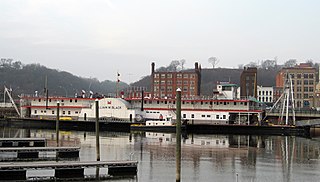
William M. Black is a steam-propelled, sidewheel dustpan dredge, named for William Murray Black, now serving as a museum ship in the harbor of Dubuque, Iowa. Built in 1934, she is one of a small number of surviving steam-powered dredges, and one of four surviving United States Army Corps of Engineers dredges. She was declared a National Historic Landmark in 1992. She is open for tours as part of the National Mississippi River Museum & Aquarium.

The Kathryn, a Chesapeake Bay skipjack, was built at Crisfield, Maryland in 1901. Ported at Chance, Maryland, she is reputedly one of the fastest skipjacks on the Bay. She was designated a National Historic Landmark on April 19, 1994. She is one a small number of older skipjacks to survive in working condition.

The William B. Tennison is a Chesapeake Bay bugeye built in 1899 and converted to an oyster buy-boat in 1906–07. With the conversion her sail rig was removed and an engine inserted, and is the only surviving example of this conversion. Her construction marks a transition between log construction and plank construction. She is homeported at the Calvert Marine Museum in Solomons, Maryland. The Tennison is reputed to be the second oldest licensed passenger vessel in the United States.
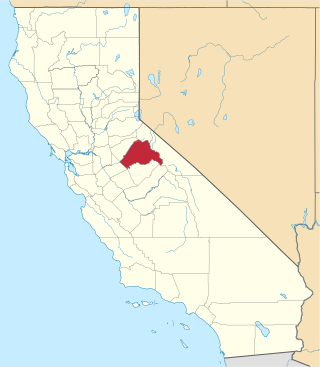
This is a list of the National Register of Historic Places listings in Tuolumne County, California.

The Coal Creek Historic Mining District is a gold-mining area in the Yukon-Charley Rivers National Preserve of Alaska dating from the 1930s. It features a gold dredge and a supporting community of several dozen buildings, established by mining entrepreneur Ernest Patty.

The Tuolumne Meadows Ranger Station and Comfort Stations are examples of National Park Service Rustic design in Yosemite National Park. They are within the Tuolumne Meadows Historic District at Tuolumne Meadows. The ranger station was built in 1924 using peeled log construction. The ranger station doubled as the park entrance station for the Tioga Road. Its function was partly superseded by a newer structure in 1936, using larger quantities of stonework.

Goldstream Dredge No. 8 is a ladder dredge operated by the Fairbanks Exploration Company from 1928 to 1959. It is located on the old Steese Highway between Fairbanks and Fox in the central part of Alaska.
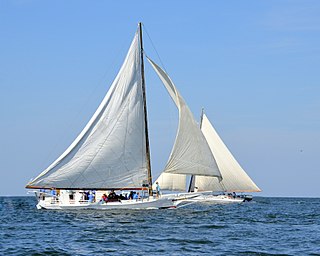
The Fannie L. Daugherty is a Chesapeake Bay skipjack, built in 1904 at Crisfield, Maryland. She is a 41.3-foot-long (12.6 m) two-sail bateau, or "V"-bottomed deadrise type of centerboard sloop. She is built by cross-planked construction methods and has a beam of 8 feet (2.4 m) and a depth of 3.6 feet (1.1 m). She one of the 35 surviving traditional Chesapeake Bay skipjacks and a member of the last commercial sailing fleet in the United States. She is located at Wenona, Somerset County, Maryland.

The Soda Springs Cabin is a historic structure in Yosemite National Park in the US, built over Soda Springs. It was built around the year 1889 by John Baptist Lembert, the first white settler on the Tuolumne Meadows area of Yosemite. Lembert had filed a claim to 160 acres (65 ha) in Tuolumne Meadows in 1885 after spending three summers in the area with a flock of angora goats. He built a log cabin directly over the largest soda spring in the area. Although the property was within the park boundaries, Lembert received a patent to the property in 1895. Lembert's cabin was built along the Great Sierra Wagon Road over the Sierra Nevada. He also became a guide for tourists in the high country, gaining a reputation as a naturalist and entomologist. He spent the winter months near Cascade Creek in the Yosemite Valley.

Derry Mining Site Camp was a mining site camp near Leadville, Colorado that operated during 1916–1923. It is located on the old Twin Lakes Toll Road, at an elevation of 9,320 feet (2,840 m). The placer mine was established on and named after the Derry Ranch established by Samuel Derry, who purchased the land in May of 1878. He homesteaded and farmed hay that was sold to feed the animals that worked in the gold rush operations in Leadville. When Derry died in 1889, his son Calaincourt Derry inherited the ranch and continued farming it until his death in 1908, at which time the ranch was sold to the Saguache Gold Mining Company, which began small-scale placer mining.

The Chatanika Gold Camp is a historic gold mining camp at Mile 27¾ of the Steese Highway in Chatanika, Alaska. The camp is set on about 49 acres (20 ha) overlooking Cleary Creek, and consists of thirteen buildings as well as a scattering of old mining tools and equipment. The largest of the buildings are two bunkhouses, finished in corrugated metal. The camp was built in 1925 by the Fairbanks Exploration Company (FEC), which also dug the nearby Davidson Ditch to supply water for the operation of the gold dredges. The Chatanika Camp was the largest of the FEC's mining camps in the Fairbanks area. Five of the surviving buildings date to the initial construction period.
The Fairbanks Exploration Company Dredge No. 2 is a historic gold mining dredge in a remote area of Fairbanks North Star Borough, Alaska, northeast of the city of Fairbanks. It is currently located on the north bank of Fish Creek, shortly northeast of the mouth of Slippery Creek. Its main structure is a compartmented steel hull, 128 feet (39 m) long, 60 feet (18 m) wide, and 12 feet (3.7 m) high, with a 1-2 story superstructure above made of steel and wood framing sheathed in corrugated metal. It has three gantries, and a digging ladder 112 feet (34 m) long at its bow that weights 178,000 pounds (81,000 kg). All of its original operating equipment was reported to be in place in 1999. The dredge was built in 1927 by the Bethlehem Steel Company, and assembled for use in Alaska in 1928. It was operated by the Fairbanks Exploration Company in the Goldstream Valley from 1928 to 1949, and on Fairbanks Creek and lower Fish Creek from 1950 to 1961.
The Fairbanks Exploration Company Gold Dredge No. 5 was a historic gold mining dredge in a remote area of Fairbanks North Star Borough, Alaska, north of the city of Fairbanks. It was last located on Upper Dome Creek, shortly northeast of the mouth of Seattle Creek, about 20 miles (32 km) north of Fairbanks, prior to its being scrapped c. 2012. The dredge was manufactured by the Bethlehem Steel Company in 1928, shipped in pieces to Alaska, and assembled by the Fairbanks Exploration Company on Cleary Creek, where it was used until 1942. It thereafter served on Eldorado Creek (1947–55) and Dome Creek (1955-59) before it was abandoned.
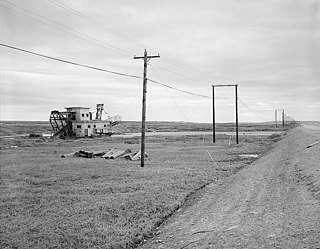
The Swanberg Dredge is one of several gold mining dredges that dot the landscape near Nome, Alaska. Also known as the Johnson-Pohl Dredge, this one is located at about mile marker 1 of the Nome-Council Highway just inside the city limits. The dredge stands in a pond about 200 feet (61 m) north of the highway in a small pond. It has a barge-like hull with a mostly single-story superstructure, and measures about 60 by 30 feet, with a draft of 6 feet (1.8 m). Its metal frame bow gantry extends about 5 feet (1.5 m), and has a digging ladder 40 feet (12 m) long. The dredge was built in San Francisco, California, shipped to Nome, and placed in operation in 1946 by Walter Johnson. The economics associated with the cost of its construction and shipment, as compared to the price of gold, worked against Johnson, who only operated it for a single season before it was seized by a local bank. It has sat in place since then, typifying the sometimes hard-luck small-time mining operations of the area.

Dredge No. 4 is a wooden-hulled bucketline sluice dredge that mined placer gold on the Yukon River from 1913 until 1959. It is now located along Bonanza Creek Road 13 kilometres (8.1 mi) south of the Klondike Highway near Dawson City, Yukon, where it is preserved as one of the National Historic Sites of Canada. It is the largest wooden-hulled dredge in North America.
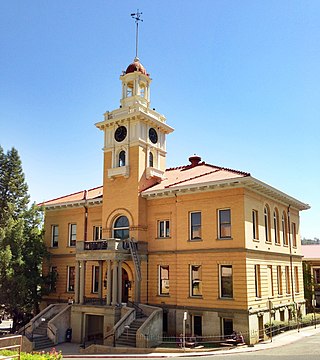
The Superior Court of California, County of Tuolumne, also known as the Tuolumne County Superior Court, is the branch of the California superior court with jurisdiction over Tuolumne County.


















